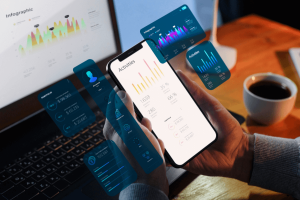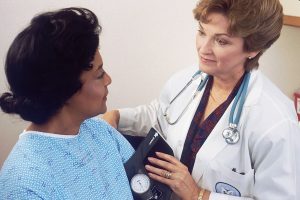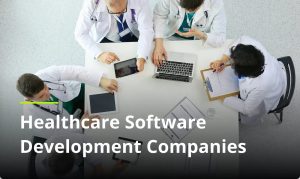5 IoT In Healthcare Applications Leading To An Improved Industry

The Internet of Things (IoT) system improves existing technologies in healthcare and general medical practice. Within a facility, the reach of professionals is growing. Due to the wide range of real-world data obtained, the accuracy and amount of medical data are increased.
Medical care delivery is also enhanced by integrating the health care system with increasingly advanced technologies with the help of healthcare app development companies.
Advanced technology drives the revolution in digital healthcare. Other medical devices include external wearables such as skin patches, insulin pumps and blood glucose monitors, medicines implanted as pacemakers, and stationary medical devices like home monitoring, connected imaging devices, and scanning machines for medical technology companies that manufacture over 5,00,000. Find best technologies that will define the future of healthcare.
The usage of medical equipment and equipment is now part of most patient interactions with the healthcare system. The healthcare sector is gradually recognizing that IoT technology has been transformed. You can hire a healthcare app developer to get your business to the hands of your audience.
Latest trends in the healthcare industry by IoT
The healthcare app development has seen a huge jump in growth and has also seen how the latest trends are growing in the industry. Let us have a look at what the figures have to say.
- Public and commercial investments in AI applications for healthcare will reach $6.6 billion by 2021.
- The health sector’s IoT sales are expected to rise from 14 billion dollars in 2016 to 135 billion dollars in 2025.
- There are already 26 billion IoT devices for healthcare worldwide that are operational, and by 2025 the figure will be 75 billion.
- This is an important cause for the rise in the number of IoT firms in the US and will drop the price of IoT sensors by 37% this year.
How is IoT shaping the healthcare industry?
The future takes place before our eyes. Nothing is more obvious as in the IoT medical industry, where a lot of technological advancements such as feature-rich devices or micro sensors have occurred in recent years. In the coming decade, though, more is anticipated.
Recent US census bureau predictions indicate that by 2025 there will be an aging population of 1.2 billion. This statistic shows that people will have a larger need for health supplies than ever before. It is foolish not to embrace the moment with this awareness.
Statistics support optimistic projections: now, the health and wellness business accounts for 70 percent of the top-selling equipment, and up to 2026, it will utilize 40% of all IoT-driven products. The health sector plans to boost its revenues by about 135 billion by 2025. IoT equipment will offer a possible $4 to $11 trillion economic boost by the same year, naturally attracting investors and start-ups, according to McKinsey Global Institute projections. Let’s look at how healthcare works in IoT.
The best 5 IoT healthcare applications that have improved the industry
For a few decades, the Internet of Things (IoT) was an issue of worldwide attention. However, the health sector has just started to realize the great potential and advantages that may be given by introducing new and more modern medical equipment, services, and interactions across various vertical components of the business.
With its infinite uses, the internet of things has re-calibrated the healthcare business. The use of IoT in healthcare began with the distant surveillance of patients by removing data from bedside devices that can assist doctors and caregivers in making better medical decisions and decreasing human interaction.
Let us have a look at the top 5 applications in the healthcare industry where IoT has shown great growth:
A complete check on the vaccines
As COVID-19 continues to spread worldwide, scientists concentrate on developing vaccines. The health of every user is greatly influenced by the safety and quality of such medical goods. In research and development, manufacturing, shipping, and usage, the safety control of vaccinations should be constantly maintained. When crossing the required threshold, IoT plays a key part in recording vaccines’ temperature and humidity. The effective presence of COVID-19 vaccinations at extremely low temperatures must be proven in line with other vaccines.
Connected inhalers
Respiratory illnesses, such as asthma and chronic pulmonary obstructive disease (COPD), increase due to air pollution, active or passive smoking, and exposure to specific chemicals or gases. The World Health Organization estimates COPD will become by 2030 the world’s third-largest cause of mortality. This drives the market for digital respiratory systems in turn. The most ordinary inhalers can be converted to clever, integrated inhalers with IoT sensors. The main drugs and inhalation data may be generated to monitor the function of the lung and illness progress.
Contact lenses
IoT contact lenses are termed intelligent lenses. Like conventional contact lenses, they may be utilized. They are placed on the eyes and include IoT sensors. Certain sophisticated, intelligent lenses include an operational replacement with an electronic one of the current lenses. It’s intended for energy collection. We are discussing two ways. Solar energy sensors convert light into electricity, while piezoelectricity sensors are another for converting mechanical blinking eye movement into electric power. They are utilized in most common health disorders, including cataracts, macular degeneration, diabetic retinopathy.
Monitoring of depression
In order to minimize melancholy and anxiety, IoT applications have emerged. A linked bracelet can, for example, monitor panic symptoms. The bracelet warns the wearer or their caretakers with soothing advice when this attack is detected. Google Assistant and Alexa may also aid individuals in identifying and providing support in the field of mental health problems.
Although the incidence of chronic illnesses is growing, the health sector is in great despair. In terms of accessibility, IoT Technology facilitates and safeguards health care in the pocket.
What are the benefits of IoT in the healthcare industry?
IoT’s relevance in health care provides the whole sector with new prospects. The greatest thing is to give value to all parties. Let us examine in more detail the health benefits of IoT:
For patients
A range of wearables can monitor illnesses and health conditions of patients (heart issues, cancer, Parkinson’S disease, diabetes, asthma) (weight, hearing, calories, mood level). For older individuals living outside the family, this is of special relevance since the linked gadgets will send a signal to a close practitioner in the event of a health threat.
For hospitals
In addition to the apparent health advantages of IoT technology such as patient health monitoring, hospitals benefit from tracking personnel and inventory sites, cleanliness control, the introduction of pill recorders, control of medical equipment, and improved medication management. Under the National Broadband Plan, the health industry will save $700 billion over the next 15-20 years through the use of Remote Patient Monitoring (RPM) combined with Electronic Health Records (EHR). There are a lot of mobile app development companies coming up to provide IoT applications in the industry.
For doctors
IoT provides physicians with increased efficiency so they may more correctly and objectively diagnose the patient’s health. In addition, Healthcare technology utilizing IoT ensures that communication with patients may be maintained even from a distance and that the data gathered give additional research material.
For business
IoT’s four-stage design offers up new business options and adds value and dynamism. Advanced analytical systems evaluate the supplied data and give important business advice for successful consequences. They are pooled and stored on a cloud.
A lot of changes are forecast by experts
To date, ingestible sensors, tracking systems, and Big Data Analytics have already been included in the healthcare industry. Healthcare IoT apps enable medical workers to use strong and comprehensive technology to monitor and track patient status. But what’s in the medical center tomorrow for IoT?
Wearables have a major societal influence on healthcare (increased quality of patient care), on the economy (reducing expenses), and scientifically with appropriate development (enabling broad citizen science). Together it is feasible to make a revolution in this sector with a flexible business strategy and better data security.
Because of the Internet of Things and medical care, as well as mobile and electronic medical information technology (ERM), an enormous quantity of data is created. This will mean that health information is processed correctly and credibly, and interactively.
The focus of health wearables will move from individual fitness instruments, which now dominate the market, to communal medical requirements, with the arrival of increasingly sophisticated IoT medical sensors and tracking systems.
Conclusion
In the long run, IoT development will provide a more healthful lifestyle, minimize health issues, illnesses and make medical services more efficient and comfortable.
Several businesses worldwide have developed outstanding concepts for integrating machine learning into intelligent wearables, gadgets, and software applications, thereby enhancing their effectiveness. When things go at the same speed, the day is not long when people are no longer visiting hospitals except in emergencies, cutting expenses, saving time, and reducing the need for physical space, as well as benefiting the environment.
Author Bio
Gourav Sharma is a Digital Marketing Strategist at Arka Softwares, a leading SharePoint development company. He has 4 years of experience in the Information Technology industry. He spends his time reading about new trends in Digital Marketing and the latest app development technologies.






